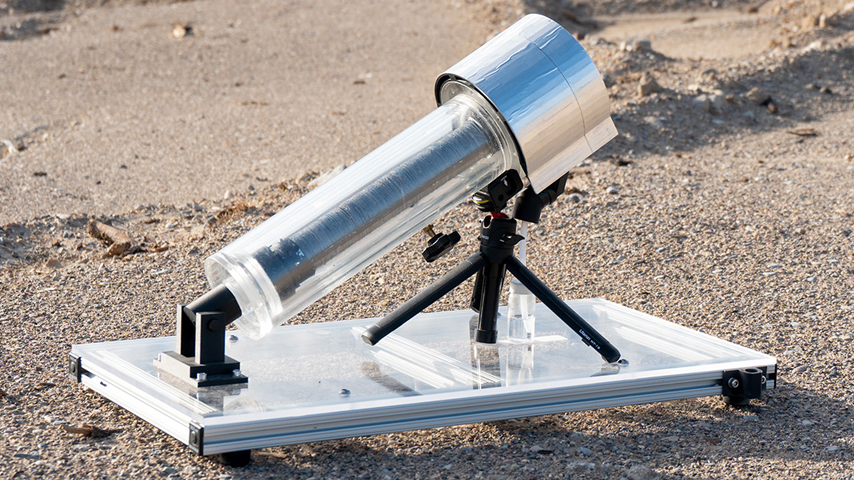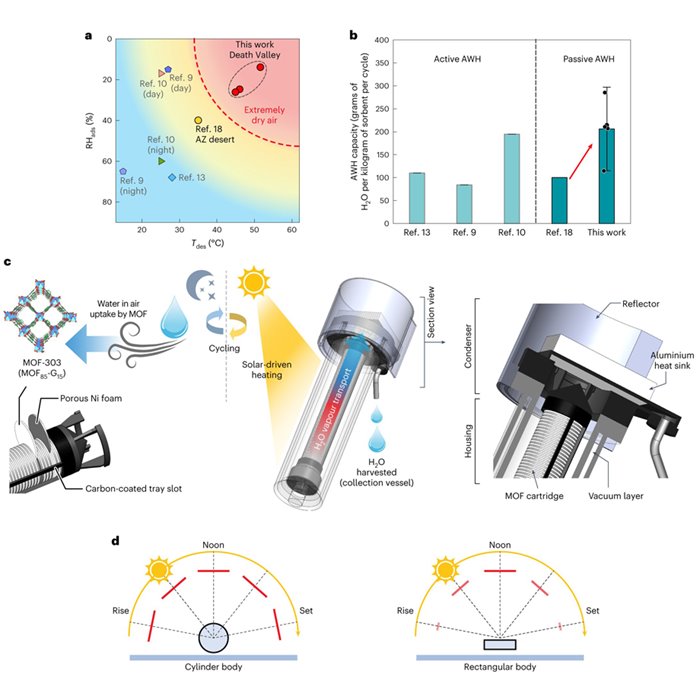Harvesting Water from the Air
Harvesting Water from the Air


A new hand-held device can harvest water from the air even in desert conditions.
According to UNESCO, more than 900 million people live in areas impacted by water scarcity, defined as having insufficient water resources to meet needs. And that number is expected to double by 2050. As a result, there is a pressing need to develop innovative and economical methods to address the issue.
Now, researchers at the University of California, Berkeley, have developed and demonstrated that a small handheld device, which leverages a special engineered material called metal-organic framework (MOF), can extract water from the air using only the power of sunlight, even in arid conditions.
Omar Yaghi, the James and Neeltje Tretter Professor of Chemistry at Berkeley, invented MOFs in the 1990s and has been studying their potential in the decades since. While studying the material’s carbon capture capabilities several years ago, he and his team discovered one type of MOF could take up water even in very low humidity.
“MOFs are a whole new chemistry, based on linking inorganic units and organic units into large porous structures on the molecular level. It looks like a white powder, but each granule on the molecular level is riddled with holes and that gives it a space within which you can trap water,” Yaghi explained. “We were using it to test carbon capture. When you try to capture carbon from the air, you have to separate the carbon from the water. We saw the MOF was taking up water in low humidity conditions and, even more exciting, would then release the water at lower temperatures.”
While other scientists have looked to salts and hydrogels to create modern water harvesters, such materials are limited. They don’t work well in low humidity, nor are they particularly energy efficient or high yielding. After observing MOF’s potential in very challenging environmental condition, Yaghi and colleagues realized its potential as a water harvester for areas of the globe that suffer from water scarcity, including desert regions.
They’ve been working with experts at Berkeley’s Bakar Institute of Digital Materials for the Planet (BIDMaP) to create a “digital innovation cycle,” to determine the optimal MOF chemistry, as well as the right form factor, to build an efficient and cost-effective water harvesting apparatus.
Become a Member: How to Join ASME
“We’ve now demonstrated that these materials, when put into a device, can harvest water from the air in even the most arduous and extreme condition including Death Valley in California, which is one of the hottest places in North America,” he said. “The MOF took up water from the air with very little humidity and then released most of it so it could be harvested using no power aside from the shining sun.”
Yaghi said it was challenging to come up with the right form factor to make best use of the MOF material. Building a small, yet efficient device required a fair amount of trial-and-error experimentation.
“You have to process a lot of air, which needs to pass through the material, to harvest the water,” he said. “Do you use thin films of MOF? Or shape particles? Ultimately, we blended MOF with a small amount of graphite to create pancakes of MOF which stack on top of each other, with space between them. That allows the air to move in and the water to move out easily.
“We also needed to build it in a way that we could maximize the exposure to the sun, with materials that were treated so we could have very efficient condensation.”
The resulting design was a hand-held device that can fit in a handbag yet has the power to harvest up to 90 percent of water from atmospheric vapor using only sunlight. When tested in Death Valley, Yaghi and colleagues were able to harvest 285 grams of water per kilogram of MOF in a single day, about a cup of water. The team is now working to scale the device to one that can deliver two liters of water per day with no electrical input.
More for You: Drinking in the Ocean Air
“I’d love to see this being used in regions of the world where there is tremendous water stress; that is my motivation,” Yaghi said. “If we can develop devices that can deliver on the order of 300 liters of water each day, it would be transformative for households all over the world.
“That device could sit outside and passively give a family drinking water, water for cleaning and hygienic purposes, and even enough to grow a little garden. This kind of technology has the potential to give people around the world water independence. It could have a remarkable impact.”
Kayt Sukel is a technology writer and author in Houston, Tex.

Now, researchers at the University of California, Berkeley, have developed and demonstrated that a small handheld device, which leverages a special engineered material called metal-organic framework (MOF), can extract water from the air using only the power of sunlight, even in arid conditions.
Metal-organic framework
Omar Yaghi, the James and Neeltje Tretter Professor of Chemistry at Berkeley, invented MOFs in the 1990s and has been studying their potential in the decades since. While studying the material’s carbon capture capabilities several years ago, he and his team discovered one type of MOF could take up water even in very low humidity.
“MOFs are a whole new chemistry, based on linking inorganic units and organic units into large porous structures on the molecular level. It looks like a white powder, but each granule on the molecular level is riddled with holes and that gives it a space within which you can trap water,” Yaghi explained. “We were using it to test carbon capture. When you try to capture carbon from the air, you have to separate the carbon from the water. We saw the MOF was taking up water in low humidity conditions and, even more exciting, would then release the water at lower temperatures.”
While other scientists have looked to salts and hydrogels to create modern water harvesters, such materials are limited. They don’t work well in low humidity, nor are they particularly energy efficient or high yielding. After observing MOF’s potential in very challenging environmental condition, Yaghi and colleagues realized its potential as a water harvester for areas of the globe that suffer from water scarcity, including desert regions.
Optimal MOF
They’ve been working with experts at Berkeley’s Bakar Institute of Digital Materials for the Planet (BIDMaP) to create a “digital innovation cycle,” to determine the optimal MOF chemistry, as well as the right form factor, to build an efficient and cost-effective water harvesting apparatus.
Become a Member: How to Join ASME
“We’ve now demonstrated that these materials, when put into a device, can harvest water from the air in even the most arduous and extreme condition including Death Valley in California, which is one of the hottest places in North America,” he said. “The MOF took up water from the air with very little humidity and then released most of it so it could be harvested using no power aside from the shining sun.”
Yaghi said it was challenging to come up with the right form factor to make best use of the MOF material. Building a small, yet efficient device required a fair amount of trial-and-error experimentation.
“You have to process a lot of air, which needs to pass through the material, to harvest the water,” he said. “Do you use thin films of MOF? Or shape particles? Ultimately, we blended MOF with a small amount of graphite to create pancakes of MOF which stack on top of each other, with space between them. That allows the air to move in and the water to move out easily.
“We also needed to build it in a way that we could maximize the exposure to the sun, with materials that were treated so we could have very efficient condensation.”
The resulting design was a hand-held device that can fit in a handbag yet has the power to harvest up to 90 percent of water from atmospheric vapor using only sunlight. When tested in Death Valley, Yaghi and colleagues were able to harvest 285 grams of water per kilogram of MOF in a single day, about a cup of water. The team is now working to scale the device to one that can deliver two liters of water per day with no electrical input.
More for You: Drinking in the Ocean Air
“I’d love to see this being used in regions of the world where there is tremendous water stress; that is my motivation,” Yaghi said. “If we can develop devices that can deliver on the order of 300 liters of water each day, it would be transformative for households all over the world.
“That device could sit outside and passively give a family drinking water, water for cleaning and hygienic purposes, and even enough to grow a little garden. This kind of technology has the potential to give people around the world water independence. It could have a remarkable impact.”
Kayt Sukel is a technology writer and author in Houston, Tex.

Business and Career Support
ASME offers flexible online courses for you and your team. Find the course that meets your needs.




.png?width=854&height=480&ext=.png)


